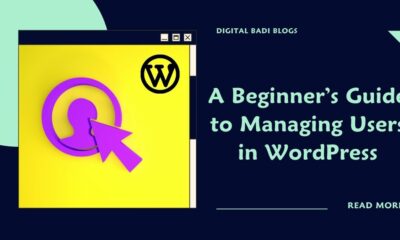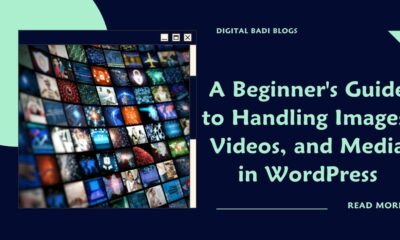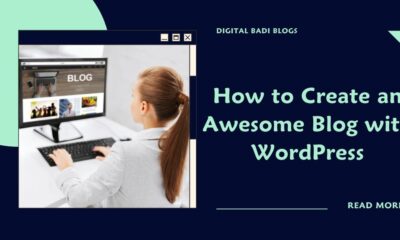Modules of Digital Marketing
What is Freelancing: A Complete Guide for Beginners

Table of Contents
What is Freelancing: A complete Guide for Beginners
Hey everyone! John here, digital marketing expert and founder of Digital Badi. In previous posts we explored various digital marketing topics to grow your business.
But today, I want to discuss a different way of working – freelancing! Whether it’s freelance writing, design, development or consulting – freelancing is becoming an increasingly popular career choice.
What is freelancing: Tour guide is a travel and tourism professional who’s self-employed and who tourists typically hire to lead them on tours of specific areas. Typically, those in this role plan detailed trips to attractions and sites in the local area to inform travelers of these places.
In this post, I’ll provide a comprehensive beginner’s guide to freelancing. We’ll cover what it entails, pros and cons, how to start freelancing, finding work, pricing services, managing clients, and tips for freelance success. Let’s get into it!
What is Freelancing?
Freelancing involves working on a self-employed basis as an independent contractor across projects for various clients. As a freelancer you:
- Offer services based on your skillset – writing, programming, consulting etc.
- Work on specific projects, gigs or contracts
- Find your own clients and manage relationships
- Set your own rates and schedules
It provides much more freedom and flexibility compared to traditional employment. You choose when, where and how much you work.
Common examples of freelance work include website development, graphic design, bookkeeping, digital marketing, and more.
Key Advantages of Freelancing
What are some of the top benefits of choosing a freelance career?
- Work from anywhere – No need to commute. Set your own location.
- Flexible schedule – Decide when and how much you want to work. Accommodate other priorities easily.
- More income potential – No salary ceiling like traditional jobs. Earn what your skills command.
- Greater freedom – Choose your clients and projects. Avoid office politics and corporate rules.
- Broaden expertise – Gain exposure to different industries, techniques and challenges.
- Own your own business – Enjoy freedom and fulfillment of being your own boss.
- Lifestyle design – Engineer the work/life balance and lifestyle you want.
Freelancing provides tremendous flexibility and control over your work and life.
Potential Downsides of Freelancing
Of course, there are also some challenges to weigh if considering freelancing:
- Inconsistent and unpredictable income – Feast or famine revenue cycles are common.
- No guarantees of work – You must continually market and sell yourself to find new business.
- Providing your own benefits – Must independently secure health insurance, retirement savings, etc.
- Isolation – Lack of social interaction and support of an office setting.
- Handling taxes and finances – Must carefully track income and expenses and pay estimated taxes.
- Work/life balance – Easy to overwork without boundaries between professional and personal.
While the freedom is enticing, freelancing comes with tradeoffs to factor in as well.
Skills and Traits for Freelance Success
Thriving as a freelancer often comes down to your skillset and personality strengths:
- Strong work ethic – Motivation and discipline to work diligently without excessive oversight.
- Self starter – Ability to independently find clients, market yourself, and pitch work.
- Organized – Critical to juggle multiple projects, deadlines, and clients effectively.
- Communication skills – Clearly convey with clients to set expectations and handle issues.
- Time management – Balance higher workload and competing priorities intelligently.
- Business savvy – Understand how to run all aspects of an independent business efficiently.
- Resilience – Persist through ups and downs common to all small businesses and volatile income streams.
Cultivating these traits sets you up for satisfaction and success as a freelancer.
How to Start Freelancing – A Step-by-Step Guide
Ready to take the leap? Here is a step-by-step guide to launching your freelance career:
1. Choose Your Niche
Select one or more focused service offerings tailored to your skills, interests and experience. Avoid trying to be a generalist.
2. Build Your Portfolio
Have a website, online samples and case studies that highlight your expertise in your niche and past work successfully delivered.
3. Master Your Chosen Tools
Become an expert in the software, programs and tools relied on to excel as a freelancer in your field.
4. Define Your Rates
Research industry averages to determine competitive yet profitable rates based on your overhead, target clients and niche.
5. Establish Your Business Structure
Figure out aspects like business registration, taxes, accounting software, contracts, legal needs etc.
6. Market Yourself
Create profiles on freelance sites, build an audience on social media, run ads, pitch clients to build a stable pipeline.
7. Optimize Your Workflow
Streamline your processes for working efficiently on multiple projects and with various clients.
8. Deliver Excellent Work
Focus on providing incredible work, meeting deadlines, and exceeding expectations to drive referrals.
Following these steps positions you for freelancing success from day one!
Where To Find Freelance Work
Once established, an ongoing key task is sourcing new freelance projects and clients. Top options include:
- Freelance websites – Create profiles on platforms like Upwork, Fiverr, Freelancer to bid on projects.
- Social media – Post your services and engage actively in your industry communities.
- Job boards – Check boards like Flexjobs, SolidGigs and Remote.co.
- Professional organizations – Join industry groups and local business organizations to network.
- Past employers – Approach previous companies you worked with for project opportunities.
- Client referrals – Ask happy clients if they can refer you to others needing your services.
- Cold pitching – Identify and reach out to potential clients directly with customized proposals.
A mix of active and passive tactics is required to maintain a solid pipeline of new business.
How Much Should You Charge? Pricing Your Services
One of the most challenging freelancing questions is how to price your services. Consider these factors:
- Industry averages – Research typical rates in your niche for baseline expectations.
- Experience level – Your expertise and past work justify higher rates.
- Client budget – Some flexibility on rates may be required for smaller clients.
- Project scope – Factor in the full extent of time and effort required.
- Value delivered – Charge premium rates if you deliver significant monetary value.
- Location – Freelancers in areas with higher costs of living can charge more.
- Demand – Increase rates if you have more leads than you can handle.
- Overhead – Account for all your operating expenses and income goals.
Take the time to get your pricing right – not too high but not leaving money on the table either.
Managing Client Expectations and Relationships
Succeeding as a freelancer also requires expertise in client relations:
- Set clear agreements – Have contracts, scope of work, payment terms, etc defined upfront.
- Ask questions – Fully understand needs and preferred working styles.
- Maintain open communication – Provide regular progress updates and quickly address any issues that arise.
- Be reliable – Deliver consistently high quality work on time as promised.
- Be likable – Go above and beyond on service and be pleasant to work with.
- Request feedback – Check in regularly on satisfaction and ask for testimonials.
- Send invoices promptly – Bill clients and follow up on payments in a timely manner.
- Rotate long-term clients – Don’t rely too heavily on one or two major clients. Keep prospecting.
Excelling at both the work and relationship leads to retained and referral business.
Tools and Tips for Productive Freelancing
Here are some additional tools and habits for maximizing your productivity:
- Schedule mindfully – Block time for deep work. Batch similar tasks. Take breaks to recharge.
- Leverage automation – Use apps like Zapier to automate repetitive tasks where possible.
- Limit distractions – Disable notifications. Schedule email in batches. Minimize context switching.
- Track time tightly – Use time tracking software religiously to understand work patterns.
- Take notes – Document client communications, requirements, key info comprehensively.
- Exercise discipline – Set office hours and work location to delineate work time.
- Outsource wisely – Delegate non-core activities like admin work to assistors.
Adopting these habits will help you work efficiently and stay focused.
Key Takeaways for Freelancing Success
Let’s wrap up with some core best practices:
- Pick a niche – Specialize in a specific service or industry rather than being a generalist.
- Set competitive rates – Don’t undercharge. Value your services. But also don’t price yourself out of the market.
- Find a blend of clients – Balance large anchor clients with smaller ones. Don’t rely solely on one or two major accounts.
- Market constantly – Never rest on your laurels. Keep networking, advertising, referrals flowing to maintain your pipeline.
- Develop repeat business – Overdeliver on work product and service to convert clients into recurring business.
- Manage finances tightly – Track income and profitability diligently. Maintain adequate cash reserves.
- Keep learning – Continuously expand your skills and keep up with changes in your industry.
I hope this guide provided an extensive yet approachable overview of how to start and run a successful freelance business. Feel free to reach out if you need any specific advice!
Now it’s time to put these tips into action. Wishing you fulfillment and prosperity on your freelancing journey!
If You are Looking for Digital Marketing Training in Hyderabad.
Contact Us : +91 9059329297
John is a Digital Marketing Trainer and Blogger and YouTube creator with 5+ years work experience in digital marketing field. He is the founder of Digital Badi.
Modules of Digital Marketing
Unlocking the Power of Excel for Digital Marketing

Table of Contents
Excel for Digital Marketing
Hey everyone! John here again, digital marketing expert and founder of Digital Badi. In previous posts we covered all aspects of digital marketing – SEO, content, social, email, paid ads and more.
But today I want to talk about an unflashy yet incredibly useful tool for marketers – Microsoft Excel.
Excel for digital marketing:some of the most common uses of Excel within digital marketing include: Analyzing web statistics. Analyzing audience metrics. Analyzing ROI within campaigns and advertisements
While Excel may seem boring compared to all the latest buzzworthy marketing tech, it remains one of the most versatile and valuable tools in a digital marketer’s toolkit. Its robust functionality allows manipulating data in ways that provide tangible insights.
In this post, I’ll explain what Excel is, why it’s useful for marketers, some of the key ways it can be applied, and tips for using it effectively. Let’s shed some light on this under-appreciated digital marketing workhorse!
What is Excel and Why Use It for Marketing?
For those completely new to spreadsheets, Excel is a software program that allows organizing, calculating, analyzing and visualizing data in tables with rows and columns.
Excel makes it easy for marketers to:
- Organize complex data sets into structured tables that can be filtered and manipulated
- Perform calculations like sum, average, percentages across multiple metrics
- Analyze data sets using sorting, pivots and charts to uncover insights
- Easily create visualizations like graphs and dashboards to illustrate trends
- Automate repetitive analysis tasks through macros to save time
- Collaborate with others and combine data sources into master data sets
The ability to take raw marketing data and derive actionable conclusions is incredibly valuable.
Key Marketing Applications of Excel
Exactly how can marketers apply the power of Excel most effectively? Here are some of the most impactful applications:
Data Cleansing and Organization
Prepare raw marketing data for analysis by:
- Combining disparate datasets into unified tables
- Removing duplicates
- Fixing formatting inconsistencies
- Adding/deleting unnecessary columns
- Filtering to refine your dataset
Campaign Performance Analysis
Review campaign metrics to identify trends and optimization opportunities:
- Pull data from analytics platforms into Excel
- Calculate KPIs like CTR, conversion rate, ROI
- Aggregate data across campaigns
- Filter and segment data by source, ad sets, placements etc.
- Create visualizations like line graphs showing performance over time
Audience Analysis
Analyze audience data to refine customer targeting:
- Build audience profiles based on attributes like demographics, interests and behaviors
- Identify high-value customer cohorts based on common attributes
- Filter data to isolate key audience segments
- Visualize audience data comparisons through graphs
Budget and Spend Optimization
Manage marketing budgets and spend efficiently by:
- Tracking budgets across campaigns, channels and months
- Calculating monthly and YoY spend by area
- Creating forecasts and remaining budgets
- Modeling different budget allocation scenarios
- Building spend dashboards with graphs and visual indicators
Content Performance Analysis
Evaluate content metrics to optimize content creation:
- Track volume, engagement and conversion data for different content
- Calculate conversion rate, social shares per post
- Rank content by performance metrics
- Illustrate trends using charts
- Filter top and bottom performing pieces for further analysis
A/B Testing Analysis
Analyze A/B test results to identify winning variants:
- Import test data from dedicated tools or analytics platforms
- Identify statistical significance to determine if differences are real
- Filter and segment by demographic factors like location or device
- Visually illustrate performance differences between variants
- Analyze changes over the testing period to watch for trends
There are so many ways Excel provides tangible, quantitative insights to refine your marketing.
Tips for Using Excel Effectively for Marketing
Follow these tips to maximize the value from using Excel for your marketing analysis needs:
- Learn keyboard shortcuts – Shortcuts speed up navigation and task efficiency.
- Use absolute and relative cell references – Easily copy formulas without breaking references to other cells.
- Name cells/ranges – Improve readability and formulas by naming cells rather than using cell addresses.
- Use conditional formatting – Highlight cells based on value thresholds for quick visual analysis.
- Filter tables – Temporarily hide irrelevant data to focus on what matters.
- Learn basic formulas – SUM, AVERAGE, COUNT, VLOOKUP, IFERROR etc. perform powerful analysis.
- Create interactive dashboards – Use forms, buttons, dropdowns and macros to build interactive dashboards.
- Use pivot tables – Quickly reorganize, group and summarize data for insights.
Don’t let Excel intimidate you. Start small and grow your skills over time. It’s a journey well worth taking!
Key Takeaways for Applying Excel to Marketing
Here are some core lessons on harnessing the analytics power of Excel:
- Start with well-structured, clean datasets for reliable analysis. Garbage in, garbage out!
- Use Excel and other BI tools in tandem. Excel augments dedicated marketing platforms.
- Build reusable templates and dashboards that pull data dynamically for quick insights each period.
- Focus on analyzing actionable data that will impact marketing decision making. Avoid paralysis by analysis.
- Excel knowledge compounds over time. Invest in continuously developing your skills through content and practice.
- Don’t underestimate the impact Excel mastery can have on your marketing analytics capabilities.
Excel remains one of the most indispensable tools in a savvy digital marketer’s toolkit. I hope this post provided some clarity on how to start applying it. Let me know if you have any other Excel-related questions!
Now get out there and start using data to take your marketing to the next level. The insights are waiting!
Contact Us to Learn Digital Marketing Course in Hyderabad.
Call to this Number : +91 9059329297
John is a Digital Marketing Trainer and Blogger and YouTube creator with 5+ years work experience in digital marketing field. He is the founder of Digital Badi.
Modules of Digital Marketing
What is Email Marketing: A Complete Guide for Beginners

Table of Contents
What is Email Marketing: A Complete Guide for Beginners
Hey everyone! John here, back again with another post in my in-depth digital marketing series. So far we’ve covered all aspects of marketing strategy, content, SEO, social media, paid ads and more.
Now I want to focus on the channel that consistently drives the highest return on investment across all marketing efforts – email.
What is Email marketing: remains an extremely effective way to engage audiences while also building relationships and driving conversions over time. In this post, I’ll provide a comprehensive yet beginner-friendly guide to email marketing success. Let’s do this!
What is Email Marketing?
Let’s start simple – email marketing refers to sending commercial messages to a list of subscribers or customers via email in order to promote your brand, products or services.
This includes:
- Collecting email addresses through opt-in forms
- Sending promotional emails like announcements, newsletters etc.
- Automating personalized email workflows and segments
- Integrating email with other marketing channels
- Measuring performance through open rates, clicks etc.
- Refining based on insights around subscriber engagement
The goal is to drive brand awareness, engagement, conversions, and loyalty through ongoing helpful email communications.
The Value Proposition of Email Marketing
So why invest in building your email marketing capabilities? Consider these powerful advantages:
- Extremely high ROI – Email averages over $42 return for every $1 spent, the highest of any marketing channel.
- Expanded reach – Build an owned audience outside of any one platform.
- Increased engagement – Messages directly hit the inbox, no algorithm or noise.
- Brand building – An email nurtures relationships and trust over time.
- Traffic driver – Strategic email campaigns direct visitors back to your site.
- Powerful automation – Sending triggered, personalized emails at scale.
- Granular analytics – Open and click tracking provide data to optimize.
- Cost efficient – Low overall cost to create and send emails at scale.
With the right strategy, email marketing delivers tremendous upside.
Key Steps for Email Marketing Success
If you’re ready to leverage the power of email, here is a proven framework:
Set Clear Goals
Define what you want to achieve – build awareness? Generate traffic? Capture leads? Reduce churn? Drive sales? Goals inform strategy.
Grow Your List
Offer compelling lead magnets in exchange for emails, capture at checkout, import existing customer lists. Continuously expand your database.
Segment Your Subscribers
Divide contacts into groups like customers, inactive subscribers, prospects etc. Personalize emails based on interests, actions and demographics.
Design Great Content
Create valuable, relevant, engaging content. Well-designed email newsletters, promotional messages, autoresponder workflows.
Automate Campaigns
Set up sequences like post-purchase follow-ups, re-engagement flows for inactive users, lead nurturing.
Integrate With Your Site
Install tracking pixels, link email to landing pages. Ensure cohesive experiences across channels.
Analyze Performance
Review open rate, click through rate, bounce rate, unsubscribers, revenue driven. Optimize and improve over time.
Check back on these fundamentals consistently for email success.
Crafting Compelling Email Content
Email content plays a major role in engagement and conversions. Here are proven tips for creating emails your audience loves opening:
Offer Exclusive Value
Special deals, early access, discounts, or content available only to email subscribers.
Write Catchy Subject Lines
Subjects should create curiosity, urgency, or provide value. A compelling subject boosts open rates.
Make Content Scannable
Use concise paragraphs, bullet points, bolded text, images, and white space for skimmability.
Focus on Benefits
Clearly explain how you solve problems or improve lives rather than features.
Use High-Quality Visuals
Include images, gifs, videos and graphics to visually engage readers.
Personalize Where Possible
Include first names, location, purchase history etc. to make emails more relevant.
Write Like a Human
Adopt a conversational tone. Don’t be overly salesy. Build a relationship with subscribers.
Make it Mobile Friendly
Test emails rigorously across mobile devices. Optimize layout and CTAs for small screens.
Email design, personalization and value drive open rates, engagement, and ultimately conversions.
Email Automation Workflows to Nurture Subscribers
Beyond one-off emails, marketing automation takes your efforts to the next level. Here are powerful types of automated email workflows to create:
Welcome Series – Post sign-up as an introduction to your brand, content, and products.
Re-engagement – Win back inactive subscribers with special offers.
Behavioral Triggers – Send based on actions – cart abandonment, feature usage, new content etc.
Event Follow Ups – Recap event attendance, gated content access or purchases.
Surveys – Ask for feedback on their experience with your brand, content, or products.
Appointment Reminders – Remind of upcoming appointments, expiring trials etc. via timely emails.
Cart Abandonment – Offer discounts and perks to users who left items in their cart.
Milestones – Acknowledge anniversaries, loyalty status, referrals etc.
Workflows nurture subscribers based on their interactions over time.
Promoting Your Emails to Increase Exposure
To maximize reach and engagement, actively promote new email content across channels:
- Share an email signup form on your site, social media, and other platforms. Offer an incentive like a discount or exclusive piece of content in exchange for subscribing.
- Post snippets of informative or entertaining content from email newsletters on social media to provide a preview.
- Show recent emails or testimonials in site headers/footers with a subscription form to capture more emails.
- Mention the value subscribers get from your emails in any guest articles, Q&As or interviews. Include a CTA to subscribe.
- Repurpose top performing email content into blogs, social posts, ads.
- Share links to your latest emails in relevant groups and communities.
Expanding exposure drives more signups and engagement with your existing emails. Promote aggressively but don’t spam.
Key Email Marketing Metrics to Track
To refine your email approach, diligently track:
- Open rate – Percentage of recipients opening your emails
- Clickthrough rate – Clicks on links and CTAs within emails
- Bounce rate – Emails “bouncing” due to invalid addresses. Keep below 5%.
- Unsubscribe rate – Monitor opt-outs to identify poor content. Below 0.5% is solid.
- List growth – Growing your list expands your audience reach.
- Engagement funnel – % who open emails, click, convert after clicking.
- Sales revenue – Ecommerce brands can track revenue from email clicks directly in tools like Mailchimp.
Regularly analyzing performance identifies areas for optimization and provides accountability.
Common Email Marketing Pitfalls to Avoid
Here are some key mistakes that sink email success:
- Buying email lists – Illegally spamming purchased lists tanks deliverability. Grow organically.
- Sending too frequently – Don’t flood inboxes. Send only high quality, helpful content on an ideal cadence for your audience.
- Putting email on autopilot – Consistently refine based on open and clickthrough rates.
- Not tracking analytics – Key data like opens, clicks, unsubscribes, drive growth.
- Poor subject lines – Vague or misleading subjects increase bounces and opt-outs.
- Overstuffing copy – Limit copy to increase scannability with images, spacing, and formatting.
- Neglecting mobile – Don’t forget over half of emails are opened on mobile now. Simplify.
With the right focus on providing subscriber value in a thoughtful cadence, email drives significant ROI. Avoid common mistakes through constant testing and optimization.
That wraps up my complete guide to crushing it with email marketing! Let me know if you have any other questions. I’m happy to help further demystify one of the most effective yet underutilized marketing channels.
Now get out there and start connecting with your audiences in their inbox!
Contact Us to Learn Digital Marketing Course in Hyderabad.
Call to this Number : +91 9059329297
John is a Digital Marketing Trainer and Blogger and YouTube creator with 5+ years work experience in digital marketing field. He is the founder of Digital Badi.
Modules of Digital Marketing
What are Web Analytics: A Beginner’s Guide

Table of Contents
What are Web Analytics:A Beginner’s Guide
Hey everyone! John here again, digital marketing expert and founder of Digital Badi. In previous posts we covered all aspects of digital marketing – SEO, content, social, email, paid ads and more.
But none of those tactics matter if you can’t measure their impact. That’s where web analytics comes in. Analyzing performance data is absolutely crucial for digital marketing success.
What are Web analytics is the process of analyzing the behavior of visitors to a website. This involves tracking, reviewing and reporting data to measure web activity
In this post, I’ll provide an in-depth yet beginner-friendly guide to leveraging web analytics. We’ll cover what it is, why it matters, types of analytics, key performance indicators, tools of the trade, and common mistakes to avoid. Let’s dive in!
What Exactly is Web Analytics?
Let’s start simple – web analytics refers to the collection, measurement, analysis and reporting of website and app data to understand online visitor behavior and activity.
Typical web analytics provide insights into:
- Traffic volume and sources
- Visitor actions, clicks and conversions
- Acquisition channels driving growth
- Landing pages and campaigns generating results
- User experience obstacles
- ROI of initiatives
Essentially, analytics help you interpret the data to optimize your online presence and marketing.
Why Web Analytics Matter
You might be wondering – why should I bother with analytics? Just trust that my site and marketing are working fine, right?
Wrong. With comprehensive analytics, you gain:
- Informed decision making – Identify high-performing channels and initiatives to double down on.
- Performance tracking – Monitor progress against key growth and revenue goals.
- Optimization – Isolate problem areas hurting conversion to improve.
- Accountability – Quantify marketing ROI and impact on business.
- Competitive insights – See where competitors are getting traction.
- Audience insights – Discover more about your visitors and buyers.
- Automation – Trigger actions based on data to nurture visitors.
Solid web analytics provide the visibility required to maximize results.
Key Types of Analytics to Track
Now let’s explore the primary categories of analytics to focus on:
Site Analytics
This includes your overall website traffic volume, sources, visitor actions, conversions, acquisition channels, landing pages, and campaigns driving growth.
Platforms like Google Analytics offer robust site analytics.
Marketing Campaign Analytics
Dive deeper into performance metrics for individual marketing campaigns across channels like email, paid search and social.
Evaluate impressions, clicks, conversions, cost per conversion, ROI.
Content Engagement Analytics
Look at metrics like pageviews, time on site or page, bounce rate, scroll depth and conversions for blog posts, tools and other content assets.
Identify your best performing content to optimize.
Social Media Analytics
Review followers, likes, shares, comments, clicks, engagement rate and overall reach across social platforms.
Informs your ongoing social strategy.
Mobile and App Analytics
Consider key metrics around mobile vs desktop performance, app installs, adoption, retention, feature usage and more.
Essential for optimizing mobile initiatives.
Track each of these layers to get a complete performance picture.
Key Website KPIs and Metrics to Track
Within your overall analytics, pay close attention to these critical website KPIs:
Traffic
- Sessions, visitors, pageviews
- New vs returning visitors
- Traffic sources – direct, referral, organic, social, email
Acquisition
- Volume from each marketing channel
- Channel ROI – revenue driven vs spend
- Campaign/initiative ROI
Behavior
- Pages visited per session
- Average session duration
- Bounce rates
- Shopping cart additions vs abandonment
Conversions
- Form fills, signups, purchases
- Email list growth
- Contact or call volume
- Chat engagement
Custom Goals
- Set custom goals to track important site actions unique to your business.
Consistently analyzing this data enables insightful, metrics-driven marketing decisions.
Top Web Analytics Tools
Now let’s discuss some of the top analytics platforms to consider:
Google Analytics – The most widely used free option with robust features. Integrates with Google ads.
Adobe Analytics – Full featured premium enterprise analytics. More complex but also powerful.
Mixpanel – Excellent for mobile and app analytics with user segmentation.
Amplitude – Tracks detailed user actions with cohort analysis. Optimized for product analytics.
Kissmetrics – Focused on cohort analysis, funnels and customer engagement over time.
Heap – Provides retroactive analytics on past user actions instead of needing upfront tracking.
Hotjar – Adds heatmaps, surveys, screen recordings and user session replays.
Google Tag Manager – Makes adding all tracking codes and pixels easy in one place.
Start with Google Analytics then add other platforms over time as your needs evolve.
Avoiding Common Analytics Mistakes
Finally, sidestep these common web analytics pitfalls:
- Neglecting to set up analytics initially to establish a data baseline
- Not identifying your most important business goals and KPIs to track
- Overwhelming your team with too many metrics and dashboards to analyze
- Reviewing analytics just periodically vs continuously optimizing
- Lacking context around why changes occur – don’t just assume reasons
- Having analytics and your other systems like CRM in silos rather than integrated
- Only looking at site-wide data rather than drilling into landing pages, campaigns etc.
- Making knee-jerk reactions to short term data rather than identifying long term trends
Solid web analytics is crucial, but requires the right focus on insights that drive growth.
I hope this guide has removed some of the complexity around leveraging web analytics! Let me know if you have any other questions.
Now get out there and start unlocking the data to inform your digital marketing efforts. The insights are waiting!
Contact Us to Learn Digital Marketing Course in Hyderabad.
Call to this Number : +91 9059329297
John is a Digital Marketing Trainer and Blogger and YouTube creator with 5+ years work experience in digital marketing field. He is the founder of Digital Badi.
-

 Digital Marketing2 years ago
Digital Marketing2 years agoTraditional Marketing vs Digital Marketing
-

 Telugu Blogs2 years ago
Telugu Blogs2 years agoడిజిటల్ మార్కెటర్ కి ఉండాల్సిన స్కిల్స్ ఏంటి?
-

 Telugu Blogs2 years ago
Telugu Blogs2 years agoడిజిటల్ మార్కెటింగ్ నేర్చుకోవడం ఎలా ?
-

 Graphic Designing2 years ago
Graphic Designing2 years agoCareer Opportunities in Graphic Designing
-

 Digital Marketing2 years ago
Digital Marketing2 years agoStory of Rakesh Bandari (Rakesh Ranks)
-

 Telugu Blogs2 years ago
Telugu Blogs2 years agoప్రీలాన్సింగ్ ద్వారా ఆన్లైన్లో డబ్బులు సంపాదించడం ఎలా?
-

 Digital Marketing2 years ago
Digital Marketing2 years agoSearch Engine History
-

 Video Editing2 years ago
Video Editing2 years agoCareer Opportunities in Video Editing




















